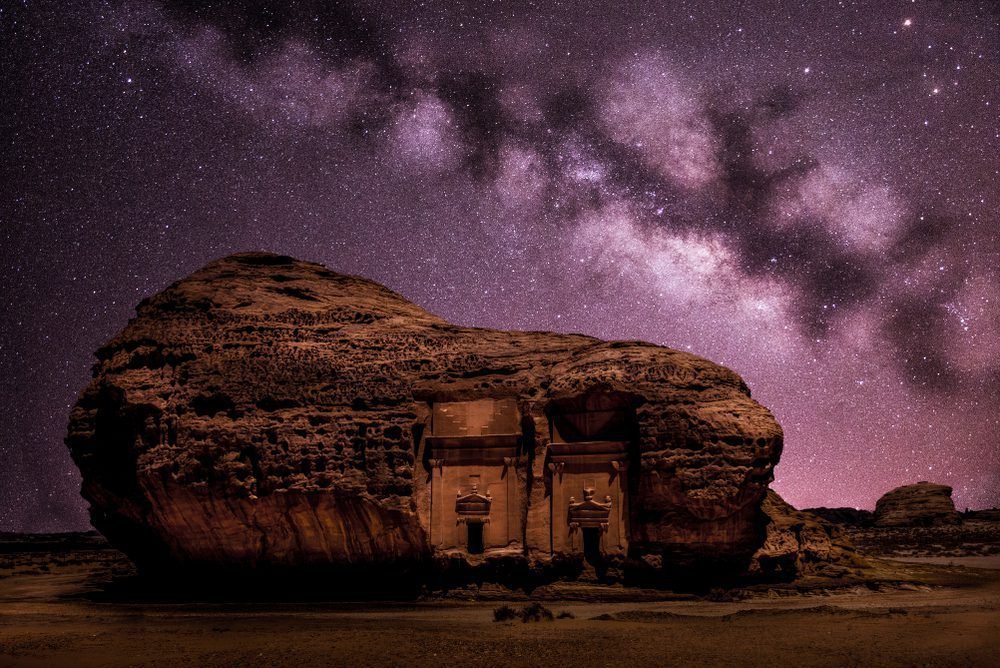

AlGharameel, a hidden gem in Saudi Arabia, offers stargazers an unforgettable experience. Far from city lights, this remote spot boasts crystal-clear skies that come alive at night.
Visitors can see countless stars, planets, and even the Milky Way with the naked eye. The area’s low light pollution makes it perfect for spotting shooting stars and rare celestial events. Astronomy enthusiasts bring telescopes to get a closer look at distant galaxies and nebulae. The peaceful desert setting adds to the magic, with gentle breezes and the soft sounds of nature. Stargazing in AlGharameel is more than just looking up; it’s a chance to feel small in the vastness of the universe and marvel at the beauty of the night sky.
Whether you’re a seasoned astronomer or simply curious about the stars, AlGharameel promises a breathtaking view of the cosmos that will leave you in awe.
1. Introduction to AlGharameel’s Night Sky
1.1. Location and geography of AlGharameel
AlGharameel, a coastal town nestled along the eastern shoreline of the Arabian Peninsula, offers a unique backdrop for stargazing enthusiasts. Its location, away from major urban centers, provides an ideal setting for observing the night sky. The town is surrounded by vast desert expanses and bordered by the Arabian Sea, creating a perfect blend of terrestrial and celestial beauty.
1.2. Climate and weather conditions ideal for stargazing
AlGharameel experiences a hot desert climate, characterized by long, dry summers and mild winters. This climate pattern, combined with low humidity levels, creates excellent conditions for stargazing throughout most of the year. The best periods for stargazing typically occur between October and April when temperatures are more moderate and skies are often clear.
1.3. Light pollution levels and their impact on visibility
One of AlGharameel’s greatest assets for stargazers is its low light pollution levels. The town’s small population and minimal industrial activity contribute to darker skies, allowing for better visibility of celestial objects. However, it’s worth noting that the best stargazing spots are found outside the town limits, where artificial light is virtually non-existent.
2. The Science of Stargazing
2.1. Basic astronomy concepts for beginners
For those new to stargazing, understanding a few basic concepts can enhance the experience:
- Celestial sphere: An imaginary sphere surrounding Earth, onto which celestial objects appear to be projected.
- Constellations: Patterns of stars that form recognizable shapes in the night sky.
- Magnitude: A measure of the brightness of celestial objects as seen from Earth.
- Light-year: The distance light travels in one year, used to measure vast cosmic distances.
2.2. Constellations visible from AlGharameel
AlGharameel’s geographical location offers a view of both northern and southern hemisphere constellations. Some prominent constellations visible throughout the year include:
- Orion: Easily recognizable by its distinct “belt” of three aligned stars.
- Ursa Major: Contains the well-known Big Dipper asterism.
- Scorpius: A striking constellation resembling a scorpion, visible in summer.
- Cassiopeia: Shaped like a ‘W’ or ‘M’, visible year-round in the northern sky.
2.3. Seasonal changes in the night sky
The night sky in AlGharameel changes throughout the year due to Earth’s orbit around the Sun. Different constellations become visible during different seasons:
- Spring: Leo, Virgo, and Bootes take center stage.
- Summer: The Summer Triangle (Vega, Deneb, Altair) dominates the sky.
- Autumn: Pegasus and Andromeda become prominent.
- Winter: Orion, Taurus, and Gemini are easily visible.
3. Planning Your Stargazing Date
3.1. Best times of the year for stargazing in AlGharameel
While stargazing is possible year-round in AlGharameel, certain periods offer optimal viewing conditions:
- November to February: Cool temperatures and clear skies make this period ideal for extended stargazing sessions.
- August: The Perseid meteor shower peaks, offering a spectacular celestial show.
- December: The Geminid meteor shower provides another opportunity for romantic sky-watching.
3.2. Essential equipment and supplies to bring
To ensure a comfortable and enjoyable stargazing experience, consider bringing:
- Warm clothing and blankets (even in a desert, nights can be chilly)
- Reclining chairs or a picnic blanket
- Red flashlight (to preserve night vision)
- Binoculars or a small telescope
- Star charts or a stargazing app
- Snacks and drinks
- Insect repellent
3.3. Choosing the perfect stargazing spot
The best stargazing locations in AlGharameel are:
- Desert areas outside the town: Offer the darkest skies and unobstructed views.
- Coastal spots: Provide a romantic setting with the sound of waves in the background.
- Elevated areas: Hills or dunes can offer panoramic views of the night sky.
Always ensure you have permission to access these areas and inform someone of your plans for safety reasons.
4. Romantic Activities Under the Stars
4.1. Stargazing picnics and what to pack
A stargazing picnic can add a touch of romance to your celestial date. Consider packing:
- A variety of finger foods (sandwiches, fruits, cheeses)
- Thermos with hot beverages (tea, coffee, or hot chocolate)
- Battery-powered candles or lanterns for ambiance
- Comfortable seating or cushions
- Bluetooth speaker for soft background music
4.2. Storytelling and mythology associated with constellations
Many constellations have fascinating stories associated with them. Sharing these tales can be a romantic and educational activity:
- Orion and Scorpius: A tale of a mighty hunter and the scorpion that defeated him.
- Cassiopeia: The story of a vain queen punished by the gods.
- Perseus and Andromeda: A classic hero’s tale of rescue and love.
4.3. Couples’ stargazing games and activities
Engage in fun activities to make your stargazing date more interactive:
- Constellation scavenger hunt: Challenge each other to find specific constellations.
- Star trivia: Prepare interesting facts about stars and planets to share.
- Wish upon a star: Take turns making wishes on the brightest stars you see.
- Create your own constellations: Use your imagination to form new patterns in the sky.
5. Capturing the Moment
5.1. Astrophotography basics for couples
Astrophotography can be a rewarding way to memorialize your stargazing date. Basic tips include:
- Use a tripod to keep your camera steady.
- Set your camera to manual mode for full control.
- Use a wide-angle lens to capture more of the night sky.
- Focus manually, as autofocus may struggle in low light.
5.2. Best camera settings for night sky photography
Optimal settings for night sky photography typically include:
- High ISO (1600-3200, depending on your camera’s capabilities)
- Wide aperture (f/2.8 or wider if possible)
- Long exposure times (15-30 seconds for stars, longer for star trails)
- Use the camera’s self-timer or a remote shutter release to avoid camera shake.
5.3. Creative ideas for starry couples’ portraits
Capture your romantic stargazing experience with these creative photo ideas:
- Silhouette portraits against the starry sky
- Light painting with flashlights to create unique effects
- Star trail photos with you and your partner in the foreground
- Composite shots combining separate exposures of the sky and yourselves
6. Enhancing Your Stargazing Experience
6.1. Using stargazing apps and guides
Several smartphone apps can enhance your stargazing experience:
- Stellarium: Offers a detailed star map and planet finder.
- Sky Map: Uses your phone’s sensors to identify celestial objects as you point your device at the sky.
- Night Sky: Provides augmented reality views of constellations and planets.
6.2. Joining local astronomy clubs or groups
Connecting with local astronomy enthusiasts can provide valuable insights and opportunities:
- AlGharameel Stargazers Club: Offers monthly meetings and stargazing events.
- University of AlGharameel Astronomy Department: Occasionally hosts public lectures and viewing nights.
6.3. Participating in stargazing events in AlGharameel
Keep an eye out for special stargazing events in the area:
- Annual Desert Star Party: A weekend-long event featuring telescopes and expert talks.
- Meteor shower viewing parties: Organized during major meteor showers like the Perseids and Geminids.
- World Space Week celebrations: Often include stargazing activities and astronomy workshops.
7. Safety and Etiquette
7.1. Night safety tips for outdoor stargazing
Ensure your safety while stargazing with these precautions:
- Inform someone of your plans and expected return time.
- Bring a fully charged mobile phone for emergencies.
- Carry a basic first-aid kit.
- Be aware of local wildlife and take appropriate precautions.
- Bring plenty of water to stay hydrated.
7.2. Respecting the environment and local regulations
Practice responsible stargazing:
- Follow “Leave No Trace” principles: Pack out all trash and leave the area as you found it.
- Respect private property and protected areas.
- Use existing paths and avoid damaging vegetation.
- Observe fire bans and restrictions on open flames.
7.3. Stargazing etiquette and consideration for others
Be mindful of other stargazers:
- Use red lights instead of white to preserve everyone’s night vision.
- Keep noise levels low to maintain a peaceful atmosphere.
- Ask permission before approaching or using someone else’s telescope.
- Avoid using flash photography, which can disrupt others’ viewing.
8. Summary
AlGharameel offers a unique and romantic setting for stargazing, with its dark skies, favorable climate, and stunning natural backdrop. By understanding the basics of astronomy, choosing the right location and time, and preparing adequately, couples can enjoy unforgettable nights under the stars. Whether you’re capturing the moment through photography, learning about celestial mythology, or simply enjoying each other’s company, stargazing in AlGharameel provides a perfect blend of romance, education, and natural beauty.
9. Frequently Asked Questions
9.1. What is the best time of night for stargazing in AlGharameel?
The best time for stargazing is typically a few hours after sunset, when the sky is at its darkest. In AlGharameel, this is usually between 9 PM and midnight. However, different celestial objects may be visible at different times, so it’s worth consulting a star chart or app for specific viewing times.
9.2. Do I need a telescope to enjoy stargazing?
While a telescope can enhance your stargazing experience, it’s not necessary to enjoy the night sky. Many constellations, planets, and even the Milky Way can be observed with the naked eye or a pair of binoculars. Start with unaided observation and progress to more advanced equipment as your interest grows.
9.3. How can I identify planets in the night sky?
Planets often appear as bright, non-twinkling points of light. Venus, Mars, Jupiter, and Saturn are frequently visible to the naked eye. Using a stargazing app can help you locate and identify planets based on their current positions in the sky.
9.4. What should I wear for a comfortable stargazing experience?
Dress in layers, even in a desert environment like AlGharameel. Nights can be surprisingly cool, especially when you’re stationary for long periods. Comfortable, closed-toe shoes, long pants, and a warm jacket are recommended. Don’t forget to bring a hat and gloves during cooler months.
9.5. Are there any guided stargazing tours available in AlGharameel?
Yes, several local tour operators offer guided stargazing experiences in AlGharameel. These tours often include transportation to prime viewing locations, use of telescopes, and expert commentary from experienced astronomers. Check with the local tourism office or search online for current offerings and booking information.
